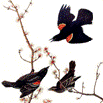Wildlife Damage Management, Internet Center for
Document Type
Article
Date of this Version
September 1970
Abstract
The 1969-70 nationwide winter inventory of blackbird-starling roosts and populations was conducted during the period December 20-January 31 by the Division of Wildlife Research, U.S. Bureau of Sport Fisheries and Wildlife. The Patuxent Wildlife Research Center coordinated the survey for the East (31 States), and the Denver Wildlife Research Center for the West (17 States). Success depended on extensive cooperation from many sources: Bureau agencies, especially the Division of Wildlife Services; other Federal and State conservation and agricultural departments; the Audubon Society; ornithological clubs; and individual bird students.
In all, 674 roosts were reported-—262 in the East and 412 in the West. The total estimated population was 340 million birds: 267 million blackbirds and starlings in the East and 73 million in the West. The national population was composed of 10 species, about as follows: 40 percent red-winged blackbirds, 20 percent starlings, 20 percent common grackles, 15 percent brown-headed cowbirds, 3 per¬cent Brewer's blackbirds, and 1 percent rusty blackbirds; the other 1 percent included boat-tailed grackles, yellow-headed blackbirds, tricolored blackbirds, and bronzed cowbirds.
Of the 262 roosts reported in the East, 77 were classed as major (a million or more birds each) and 57 as large (hundred thousand—million birds each); these 134 roosts contained 265 million of the 267 million blackbirds and starlings reported in the East. Of the 412 roosts in the West, 24 were major and 41 were large; these 65 roosts contained 70 of the 73 million Western birds reported. Thus, 98½ percent of the U.S. blackbirds and starlings found were in 199 roosts (101 major roosts and 98 large roosts), or in 30 percent of the 674 reported roosts.


